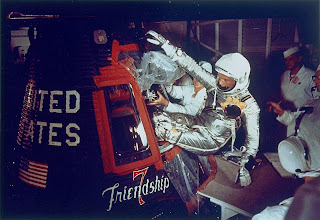by Patrick J. Walsh
When John Glenn rode his Friendship 7 Mercury space capsule into orbit on February 20, 1962, he elevated the U.S. space effort onto an even par with the manned space program of the country’s superpower rival, the Soviet Union. His flight was celebrated for the achievement it represented for the astronaut and for the space agency that had made it possible, and as a victory for the United States in the nation’s Cold War competition with the Soviets.
With the benefit of hindsight on the fiftieth anniversary of the event, it is easy to celebrate the significance of Glenn’s Friendship 7 odyssey while missing the intensity of the drama that accompanied it. There was, for example, the urgency expressed by the American media and felt by the American public that pressured NASA to achieve an orbital mission after two sub-orbital Mercury flights, during a period when the Soviets had already achieved two piloted trips in orbit. Similarly, there was an implication -- often made explicit by the Soviet political leadership -- that falling behind in the ‘space race’ was the same as falling behind in military capability and technical prowess, as well as lagging in the competition for the ‘hearts and minds’ of other nations.
Thus the courage and capability displayed by America’s first astronauts accounted for far more than the successful achievement of the goals of a particular mission. The flights required a heroism far-sighted enough to understand the larger importance of one’s own actions, as well as the concentration necessary to focus on every detail necessary to the success of each objective along the way.
 |
| John Glenn enters the Friendship 7 Mercury spacecraft prior to his landmark flight as the first American to orbit the Earth. Photo courtesy of NASA (www.nasaimages.org). |
In the particular case of John Glenn, the decency and patriotism at the heart of his upbringing and his personality were ample resources for his success as an astronaut, and his military training and piloting skills equipped him well for flying the other-worldly Mercury “space capsule.” Further supported by the nation’s foremost engineering minds at NASA, he could reasonably expect his landmark flight aboard Friendship 7 to proceed as planned...
And yet an unexpected drama still cropped up during the flight, when an instrument reading from the spacecraft -- then in the midst of its second orbit -- indicated that the lifesaving heat shield at the bottom of the capsule, which was vital to protecting the astronaut and the vehicle during the reentry stage of the flight -- had somehow come loose.
The unexpected tension -- and ultimate triumphant -- of John Glenn’s landmark spaceflight on February 20, 1962 is covered in detail in “Five Minutes in Space -- Friendship 7: A Flicker in Orbit.”
It was perhaps a fitting metaphor that the drama that elevated NASA’s carefully planned first orbital flight into a worrisome ordeal would ultimately prove as passing as the faulty instrument reading that gave rise to it in the first place. Memories of that wintry day would still, some five decades later, be adorned with images of the handsome, smiling space pilot, celebrated by his grateful fellow citizens with presidential acclaim and a joyful parade in the nation’s signature city.
John Glenn would triumph, as the courageous astronaut in Friendship 7; the dedicated senator from Ohio for a quarter century; and again as the oldest individual to fly in space, when he flew aboard the STS-95 flight of the space shuttle Discovery in 1998.
© 2012 Patrick J. Walsh
No comments:
Post a Comment